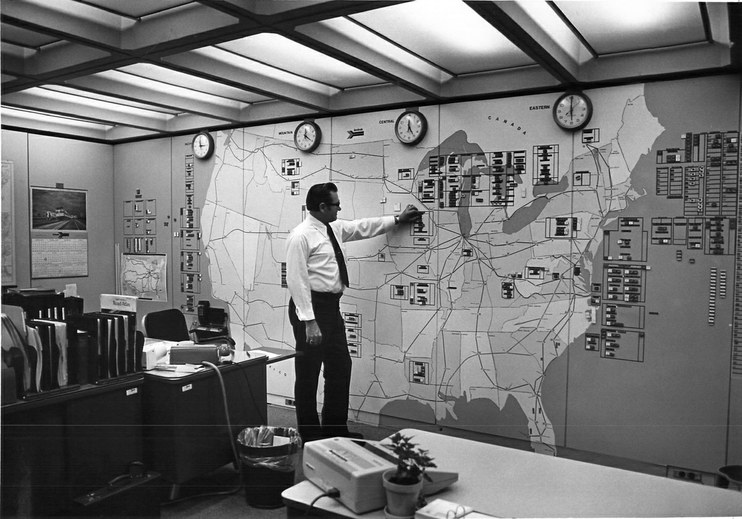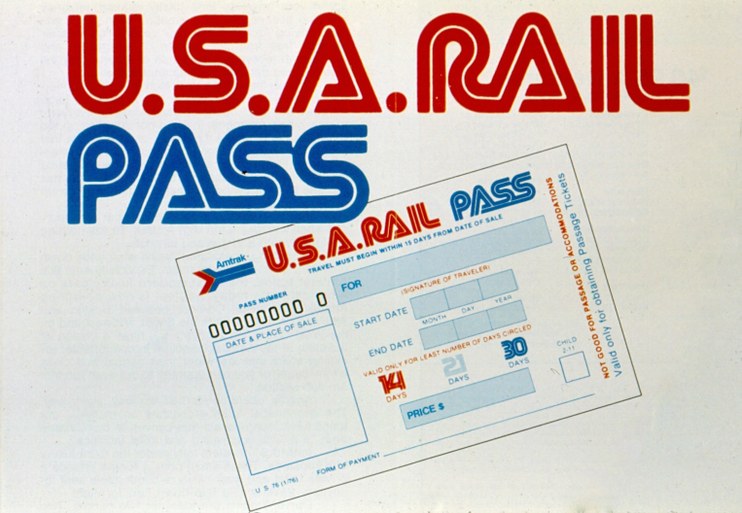Amtrak Year-by-Year: 1976
CommentsSeptember 13, 2012
 The United States and Amtrak had much to celebrate in 1976. Against a background of fireworks, parades, and historical reenactments commemorating two hundred years of American independence, Amtrak was on the cusp of the biggest transformation since its founding. “1976…was a year of historic proportions for Amtrak,” wrote President and CEO Paul Reistrup, “[in which it] became a full-fledged member of the railroad community.” On April 1, Amtrak officially gained control of the Northeast Corridor (NEC), a storied rail line running from Boston to Washington whose origins dated to the 1830s.
The United States and Amtrak had much to celebrate in 1976. Against a background of fireworks, parades, and historical reenactments commemorating two hundred years of American independence, Amtrak was on the cusp of the biggest transformation since its founding. “1976…was a year of historic proportions for Amtrak,” wrote President and CEO Paul Reistrup, “[in which it] became a full-fledged member of the railroad community.” On April 1, Amtrak officially gained control of the Northeast Corridor (NEC), a storied rail line running from Boston to Washington whose origins dated to the 1830s.
Up until that time, the company had never owned any trackage, but instead ran over rails belonging to dozens of independent railroads. Following the 1970 bankruptcy of Penn Central, formed only two years earlier by the merger of the Pennsylvania and New York Central railroads, the federal government had stepped in to guide the reorganization of the railroads in the Northeast. Too much was at stake for the region, as its residents relied on intercity, commuter, and freight services run over the tracks of the failing private railroad companies.
Although Amtrak had begun to plan for the takeover of the NEC in response to the Regional Rail Reorganization Act of 1973, the legal basis for the transfer of ownership occurred through the Railroad Revitalization and Regulatory Reform Act of 1976. Signed into law by President Gerald Ford, the “4R” act for the most part dealt with issues concerning freight railroads, including regulatory reform, introduction of flexible new railroad rates and expedited procedures for carrying out mergers.
Regarding the legislation, the President stated: “[It] encourages revitalization of our deteriorating rail freight system, both in the Northeast and nationwide. Second, it will provide substantial improvements in rail passenger service in the densely populated Northeastern United States…The actions set in motion by this legislation will make a significant contribution to our objectives of economic growth through private job creation, energy independence, and a strong private transportation system.”
One of the highlights of the bill was the creation of the new for-profit Conrail, a freight railroad formed from the remnants of seven bankrupt lines. As a freight operation, intercity passenger rail was not under its purview, and therefore the NEC and its passenger operations were given to Amtrak. With funds authorized under the 4R Act, Amtrak bought the NEC for $86,366,000 payable in eight annual installments.
Then, as now, the NEC was considered the busiest stretch of railroad in North America. According to the Fiscal Year 1976 Annual Report, “The Corridor is responsible for an average of 960 trains a day, including over 120 Amtrak intercity passenger trains, nearly 660 commuter trains…and more than 170 Conrail freight and mail trains.” For comparison, in Fiscal Year 2011, more than 2,200 trains operated over some portion of the Washington-Boston route each day.
The purchase included the majority of the 457 route miles between Boston and Washington, except for two sections that Penn Central had previously sold: 56 miles between New Rochelle, N.Y. and New Haven, Conn. (owned by Metro North) and 38 miles between the Massachusetts/Rhode Island border and Boston (owned by the state of Massachusetts). Other sections of track included in the purchase were the 62 miles from New Haven, Conn. to Springfield, Mass. (Springfield Line) and 103 miles between Philadelphia and Harrisburg (Keystone Corridor).
In addition, Amtrak obtained 128 railroad stations as well as maintenance shops and rail yards to service locomotives and rolling stock along the NEC. To address immediate needs, $6.3 million was allocated for emergency track work while the U.S. Department of Commerce contributed $2.1 million for the rehabilitation of major stations in cities such as Philadelphia. According to the purchase agreement, Amtrak had 180 days to assume operational responsibility, control and maintenance of the properties.
A major title of the 4R Act was the Northeast Corridor Project. Funded at $1.75 billion, it set out a plan for upgrading the NEC over five years. Improvements to tracks, stations, the electrical system, signals, and other corridor components were expected to reduce the trip time from Boston to New York to 3 hours and 40 minutes and from New York to Washington to 2 hours and 40 minutes. President Ford promised that “Trains [will travel] at speeds which are as high as technologically feasible and financially realistic…[and] through a joint effort by the Federal Government and the States and local communities involved, we will refurbish the stations along the way to make train travel more attractive and convenient.”

National Operations Center in Washington, D.C., mid-1970s.
Settlement of titles and deeds to the new properties kept Amtrak’s legal department busy while human resources handled a dramatic increase in the size of the workforce. Until agreements could be worked out among Conrail, Amtrak and the labor organizations, Conrail continued to oversee the day-to-day operation of the NEC. Some of the first Conrail employees to transfer over to Amtrak included approximately 1700 maintenance-of-way employees and signalmen. The Annual Report noted, “By September 30, 1976, over 7600 people were employed by Amtrak in the Corridor,” while the company’s total employment reached 16,527. A new NEC Operations Group was created in mid-March; National Operations oversaw the rest of the country.
The formation of Conrail also benefitted Amtrak in other ways. The most important was the acquisition of 83 miles of former Penn Central trackage between Kalamazoo, Mich. and Michigan City, Ind. used by trains such as the Blue Water Limited (Chicago-Port Huron). Soon thereafter, Amtrak initiated a two year track improvement program with the goal of achieving speeds of 79mph in order to cut travel time between Chicago and Detroit by 20 minutes. Amtrak also acquired 50 percent ownership in the Washington Union Terminal Company and the Chicago Union Station Company, both of which had been formed by original shareholder railroads to maintain those major stations as well as the associated track and rail yards. Down south at the New Orleans Union Passenger Terminal, Amtrak gained control of all aspects of its rail service.
On the passenger front, most of the 492 new Amfleet cars were finally put into service. By the end of the year, 75 percent of short-distance routes employed the equipment, which was credited with encouraging ridership. The Annual Report mentioned that the “Delivery of the new cars helped reduce the daily out-of-service ratio for rolling stock,” while also bringing down the overall average age of the fleet. Thirty F40PH locomotives were also delivered and put into service.

USA Rail Pass.Just in time for the nation’s Bicentennial, Amtrak offered the USA RAIL Pass to domestic customers. Modeled on the EURAIL Pass, it was introduced to overseas markets a year earlier and was soon carried by more than 85 travel agents in 25 foreign countries. Travelers could take as many coach trips as they wished in the specified time period (14, 21, or 30 days) simply by showing the pass in exchange for a paper ticket. Upgrades for Metroliner or first class service were possible if the pass holder paid the difference between those and the base coach fare. In a 1977 report, Amtrak analysts noted that more than three-fourths of pass holders used it for long distance travel.
Summing up the exciting year of 1976, Paul Reistrup wrote, “…Amtrak is very young, but now Amtrak is much more certain of where it is going and what must be done to get there.”
---------------------------------------------------------------------------------------------------------------------------
In addition to the above links, sources consulted include:
Amtrak National Fact Sheet (FY 2011)
Amtrak’s Northeast Corridor (FY 2010)
Annual Reports for fiscal years 1975-1977, National Railroad Passenger Corporation.




